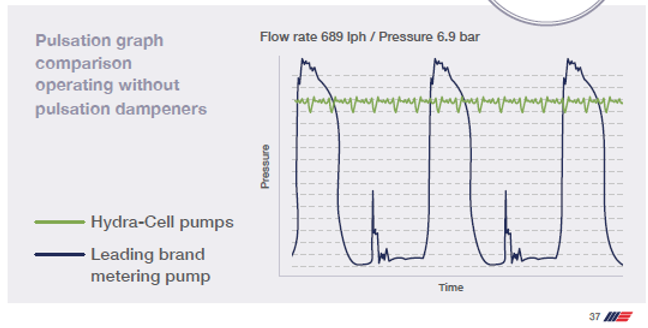
Paul Davis, Managing Director of Wanner International.
The move in manufacturing from batch processing to continuous has been reported frequently for decades, and the challenges are well documented, whether that is regulatory, data capture or more technical in terms of, for example, accuracy of dosing reactants, metering or maintaining their environment.
However some of these challenges have still to be fully resolved and this is particularly relevant as bioprocessing, with its unique use of live reactants, is increasingly being used to manufacture medicines in the volumes needed.
A technology which is widely used by the oil and gas and petrochem industries is now providing a solution to these challenges in pharmaceutical manufacture.
The Challenges Presented by this Shift to Continuous Process
One of the technical problems moving to continuous processing is product composition control. This is significantly affected by the pumps which drive the reacting fluid through the system. Pumps that are not able to regulate flow rate accurately make control of product composition and the whole process difficult, in a number of ways.
Flow rate can affect pressure, temperature, and the composition of the fluid. Ideally it needs to be consistent, predictable and independent of discharge pressure. It is largely dependent on the pulsation of the flow which can be minimised by reducing the pulsation of the pump.
Minimising the pulse means also ensures that the dosing of the reactants into the continuous reactors can be achieved with a high level of accuracy.
This is key, especially for those processes relying on a catalyst, where speed of reaction can markedly change depending on amount of catalyst. This can have consequences for quality of end product and can increase impurities , say if temperature exceeded limits.
Also within bio processing, fragile material is often a key part of the process. This can include cells or viruses which can be damaged if exposed to rapid changes in pressure or temperature. In some bio reactions these can also be affected by shear, where adjacent layers of fluid move parallel to each other with different speeds.
How Other Industries have Solved these Problems
The oil and gas and petrochemical industries had similar problems, albeit for different reasons. They found a solution with seal-less, packing-free, positive diaphragm pump technologies that provide a low shear pumping action, and deliver an extremely low pulse flow.
Wanner has patented this technology with their Hydra-Cell series of pumping solutions, with dosing accuracy exceeding API 675. The company has invested in in-depth research, critical for flow chemistry and HPLC applications, to design pumps that produce extremely low pulse flow and also exceed API 674 performance standards.
The Hydra-Cell technology removes the need for pulsation dampeners, delivering an accurate and smooth flow over a large adjustable range of flow rates.
The Wanner team ran a series of tests comparing two different pump technologies. The graph below shows the pulsations delivered by a typical metering pump and a Hydra-Cell pump – both without pulsation dampeners.

In another test the Hydra-Cell was set at 467 Lph and varied by less than 1 Lph (< 0.2%), well within the API 675 standard, while a single diaphragm plunger operated within a range 416-530 Lph (+/- 13%), clearly a huge increase in pulsation. The smooth, constant flow of the Hydra-Cell enabled controllable, consistent delivery of reactants to the process, and also makes using a calibration column much easier.
It achieves this by operating up to five diaphragms in sequence in a single pump head. This significantly reduces pressure pulsations to such a level that in 99.9% of applications no discharge pulsation dampener is required, reducing the cost of installation and ensuring a more consistent performance. This also eliminates pipe strain, delivering an accurate and smooth flow for flow chemistry dosing applications over a large adjustable range of flow rates .
Low acceleration head losses on the suction side are greatly reduced due to the multiple diaphragm pumping elements, which operate in sequence with short stroke lengths, compared to hydraulically balanced plunger diaphragm pumps with one, two and even three seperate pump heads.
Cross Fertilising this Technology into the Pharmaceutical Industry
This is how to reduce pulsation and is critical for flow chemistry and HPLC applications. Also key in these applications is shear.
Findings of research at the University of Wyoming published earlier this year showed that these pumps produced over 90% less shear than another typically used plunger pump technology in one common application in another industry.
Low shear ensures the liquids in pharmaceutical processes, which can be sensitive to small changes in environment, reach their target areas with their properties intact.
This pump has other characteristics which make it relevant to pharmaceuticals:
- The first is leak free. Many pharmaceutical manufacturing processes require movement of corrosive fluids. With a hermetically sealed pump chamber, these pumps do not leak by design, they eliminate leaking discharge pipes as pipe strain is significantly reduced with the practical elimination of pulsation.
- Secondly they are very energy efficient. A Hydra-Cell can reduce the total energy usage by up to a half for some industries that rely heavily on pumps for their processes.
The pump’s true positive displacement action and minimal internal losses achieve high efficiencies from pump shaft to hydraulic power; this combined with the wide range of flow rate controllability ensures optimum energy usage.
Alternative pump technologies with inherent internal losses, which get larger as internal parts wear, start to become lower in efficiency as the discharge pressure goes above 10 bar and only gets worse with increasing pressure. The Wanner positive displacement pump can handle high inlet and discharge pressures while also maintaining an accurate steady-state flow.
Continue reading from the source >> https://pharmaceuticalmanufacturer.media
